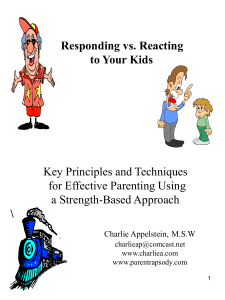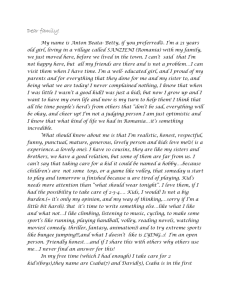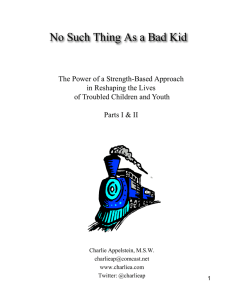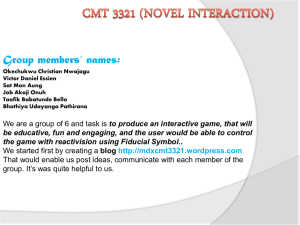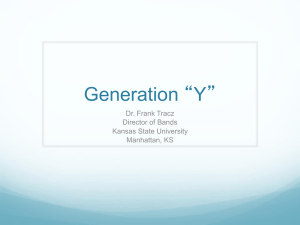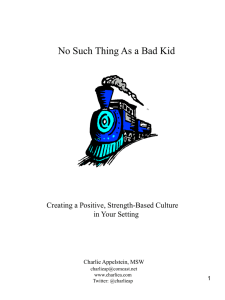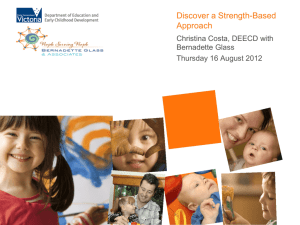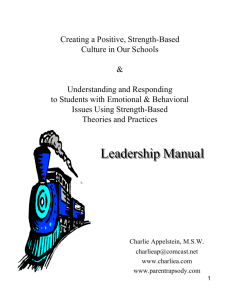NO SUCH THING AS A BAD KID
advertisement
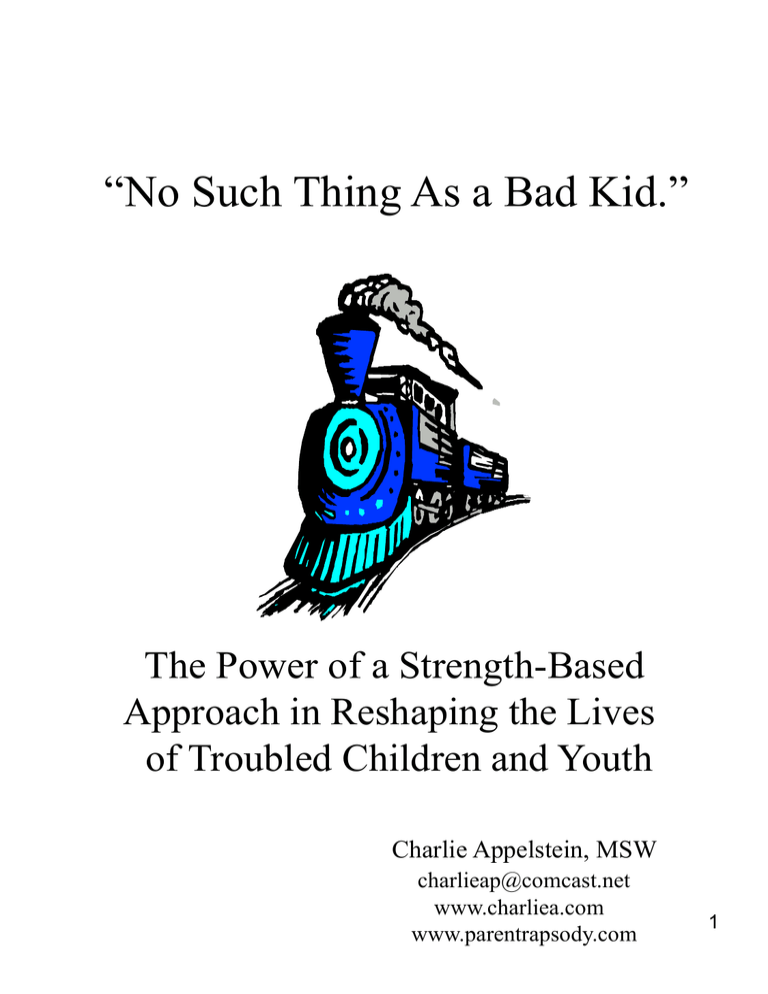
“No Such Thing As a Bad Kid.” The Power of a Strength-Based Approach in Reshaping the Lives of Troubled Children and Youth Charlie Appelstein, MSW charlieap@comcast.net www.charliea.com www.parentrapsody.com 1 Gus on Pejorative Labeling Look, I know some of us can be quite difficult. I was a hellion my first six months, considered quite obnoxious. But it was simply defensive posturing. (Can you say defense mechanism?) Kids aren’t bad. They’re just screwed up. The kid who’s pushing you away the most is probably the one who needs you the most. I think every residential center would be better off if they never used words as manipulative, lazy, un-invested, controlling, and obnoxious. They’re pejorative adjectives. When you label one of us in such a way, you contaminate the waters and no one wants to swim with us any more. “Manipulative kids aren’t fun to work with.” “They’re a pain in the ass.” “Boy , is that kid manipulative!” Every time we get blasted for being “manipulative” (or any other such term), our self-concept suffers. We take on that word – we internalize a sense of badness. Yet the kid you call “manipulative” might have come to your facility with a history of manipulating his way out of getting beaten. So, maybe manipulating ain’t so bad. Maybe it simply needs to be understood in the context of a child’s situation. Maybe people don’t need to use these words anymore. P. 24 “I had been an excellent math student, but the day she told me I was “spacey” and unfocused was the day I stopped connecting to math.” Note: Throughout this handout will be references to the manuscript: Helping Traumatized Children Learn produced by Massachusetts Advocates For Children www.massadvocates.org. Excerpt from The Gus Chronicles, Appelstein, 1994 2 Strength-Based Beliefs & Terminology Response to behavior: Understand > Reframe > Squeeze Pejorative Label Positive, Hope-Based Reframe Obnoxious Good at pushing people away Rude, arrogant Good at affecting people Resistant Cautious Lazy, un-invested Good at preventing further hurts, failures Manipulative Good at getting needs met Just looking for attention Good at caring about and loving yourself Close-mouthed Loyal to family or friends Different, odd Under-appreciated Stubborn & defiant Good at standing up for yourself Tantrum, fit, outburst Big message Learning disability Roadblocks Life isn’t what you see, it’s what you perceive! 3 Providing Hope & Possibility Through Metaphors & Positive Predicting Poker The Melting Snowball “Life is like a poker game. Even if you’re dealt a bad hand, you can still win the game.” The Roadblock “It’s not a learning disability; it’s a Roadblock. All big cities have them, but people get to work on time every day.” “See your fears and worries about (pending issue/loss/transition) as a big snowball in the middle of your chest, and understand that as each day goes by, it’s going to melt a little. It may stay forever…but it will become so small that you can build a great life around it.” TheTrain The 2009 Edition Positive Predicting When you talk about the future in positive terms, you make any desired outcome more possible. And when it’s more possible, it becomes more probable! “You’re Big and Powerful…but a bit off track.” “Cars and people improve every year. You’re the 2009 Ricky. You don’t overheat as much…have a sleeker design, follow 4 the road signs better…” Strength-Based Practice What is it?: Emerging approach to helping people that is more positive and hopeinspiring. Powerful combination of the strength-building model and solution-focused therapy Emphasis is on: Strength-building rather than flaw-fixing Doing rather than understanding Believing in every youth unconditionally - See and believe! – Not “Believing is seeing” (positive responses are earned) ..which produces Optimism – which feeds possibility, and motivates coping and adaptive behavior, even in the face of difficult odds: Hope is Humanity’s Fuel P. 57 “Lacking the words to communicate their pain, they may express feelings of vulnerability by becoming aggressive or feigning disinterest in academic success because they believe they cannot succeed.” Begins with belief that all children have strengths and past successes that can be utilized to stop troublesome behavior. Continues with practice methods that identify and marshal these strengths for necessary behavior change. The Goal: Change rather than insight and awareness The Work: Problem-driven not problem-focused (solution-focused): Devoted to helping kids initiate actions to dispense presenting problems Primarily short term Goal-oriented and focused on resolving the identifying problem Assumptions (or lack thereof)…. Strength-based practice does not assume that ownership of guilt is somehow automatically curative.…Does assume that change is inevitable, not uncertain Strength-based practice does not assume LARGE problems require LARGE efforts5for solutions.…Does assume that SMALL changes can ripple out to bring resolution. The Solution-Focused Approach The Language of Hope and Possibility! Explorative Historical: How many kids have been, or are, in similar situations? How many succeeded? So why can’t you? What steps did they take to succeed? Have you ever felt this way before and made the right choice(s) to see your way through? So why can’t you do so again? How will we celebrate when you get there? Qualifiers: “I hate this place!” > “So you’re saying you hate this place right now.” Past Tense: “I’m stupid!” > When & Will: (Positve Predicting) “I’ll never get a job!” > “When you do, what will it be like?” Scaling Questions: “On a scale of one-to-ten, ten being the highest probability of accomplishing this, what number do you think you’re at now? What number will it be in 3 months? Identifying In-Between Change: “What will be the first sign that you’ve turned the corner?” Glass Half-Full Question: (Changing Perspective Q) “How come you’re not doing worse?” “So you haven’t been feeling real smart lately.” 6 Visit: www.bobbertolino.com Activities & Self Esteem Building To help kids enhance self esteem, provide tasks and activities that offer a: Universal Opportunity for Individual Success Examples: • Modify or devise sporting endeavors that facilitate success, such as a softball game with no striking out or a basketball game in which the ball must be passed 3 times before it is shot • Academic tasks they understand and can accomplish • Physical fitness pursuits (e.g. create a chart for walking/running) • Art work that is doable; music & dance • Special chores and/or work opportunities • Games, often of chance, they can all win • Helping or mentoring younger kids or those less fortunate Every kid needs his/her own special niche! = Trumpet Success Tip: Keep scrapbooks of successes 7 Cues to Use (Coping Thoughts/One-Line Raps) Encourage kids to create and practice coping thoughts - in the form of cues or one-line raps - to diminish or eradicate problem behaviors (i.e. bad habits). Cues are more successful when they rhyme, are rhythmic, humorous and repeated often. Practice makes perfect! The brain is designed to change in response to patterned, repetitive stimulation. Anger Control NBD…easier than 1-2-3! NO BIG DEAL! Stop and think, don’t be a dink! Let it go, Joe (Just stay cool no need to blow) Let it go…So (So I can be happy or earn things, etc.) When you’re mad…don’t do bad (or don’t get sad)…just talk or walk. Talk, walk, or squawk! Stay in control, that’s the goal. I can, I will, I gotta chill. Social Take turns when you talk, if you don’t the kids will walk. Give kids their space, it’s their place. Don’t poke, it’s not a joke. Stop and think, don’t be a dink. Stay arms lengths away…today. Following Through/ Being Independent Don’t quit, take it bit by bit Use Take it little by little and play da fiddle! Like a king on a thrown, I can do it on my own. Step after step, that’s the prep. Take it inch by inch…it’s a cinch! Sit and relax, learn to the max! Make a list, it will assist. Drugs and Alcohol I can make it if I choose, time to quit the drugs and booze. If you lose hope, don’t do dope. Anxiety Don’t be in a hurry to worry. Stop and listen, cause you don’t know what you’re missing. Bongos! View more cues at www.charliea.com Encouragement/Affirmations I’m smart. It’s in my heart. Learning is your (my) ticket to a good life. I can make it if I choose…Only I can make me lose. If it is to be, it’s up to me! 8 Externalizing Negative Behaviors Giving life to a problematic issue or “bad habit” by naming it (i.e. externalizing ) can help kids rid themselves of problematic tendencies/habits/compulsions. Examples: A child who needs to do things perfectly: “Get lost Mrs. Perfecto! Get out of here. Get off my back, you loser!” A child who is prone to behavior outburst: “Get out of here Mr. Fitz!” A youth who talks rudely: “Get lost Rudy! You’re nothing!” A youth who argues incessantly: “Go far Mr. R!” “You’re through Mr. R Gue!” Rudy A child who is reluctant to write: “Get out of town, Mr. No Write!” A youth who is often late to school, or truant: “Tell Mr. I.B. Tardy/Truant not to get you in trouble next week.” Create your own: Bad Habit Name 9 ________________________________________________ ________________________________________________ Strength-Based Mission Statement We believe there is no such thing as a bad kid; just bad luck and bad choices. We believe that all individuals possess core strengths that can be utilized to lead meaningful lives. We strive to help children and their families help themselves. Our work involves mutually identifying, developing, encouraging, practicing, and maximizing the inherent strengths in every individual we engage. To accomplish our program’s goals we establish a positive, upbeat, and safe environment that instills hope, provides multiple opportunities for success, and, at all times, adheres to the golden rule. We believe a good life is all about making good choices. Although we have deep respect and empathy for where our clients have been, our major focus on the present and the road ahead. 10


